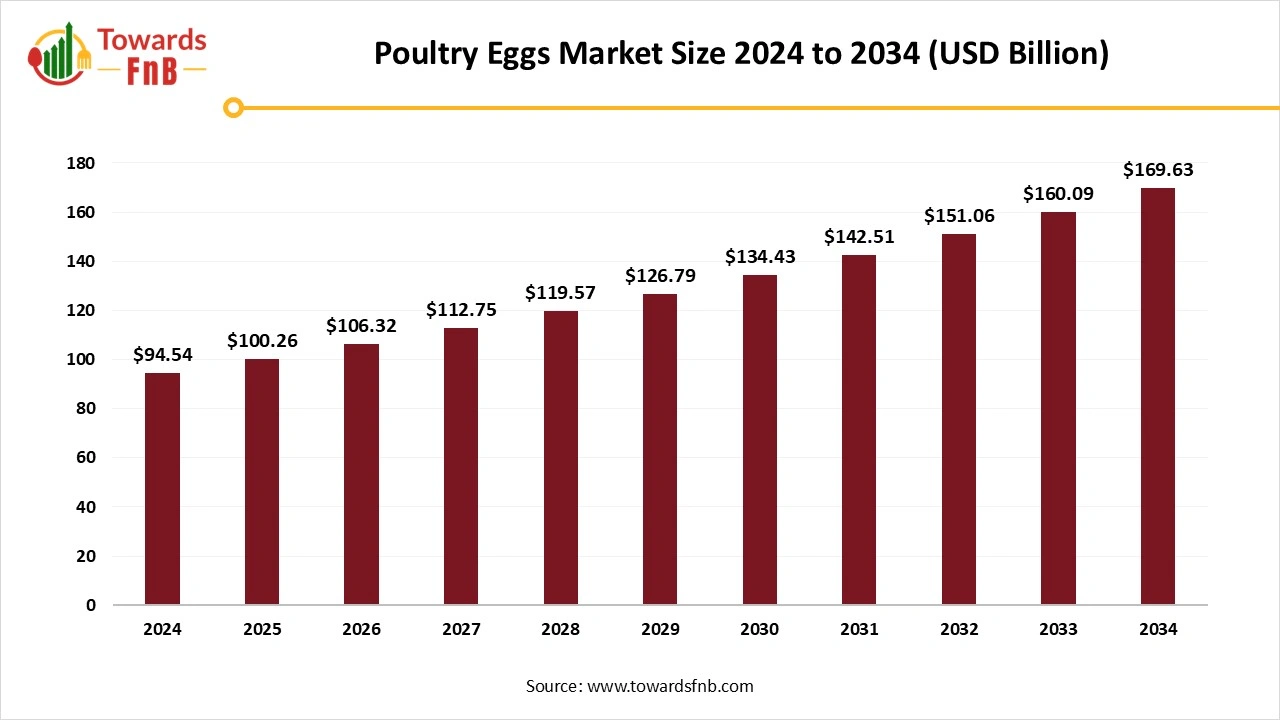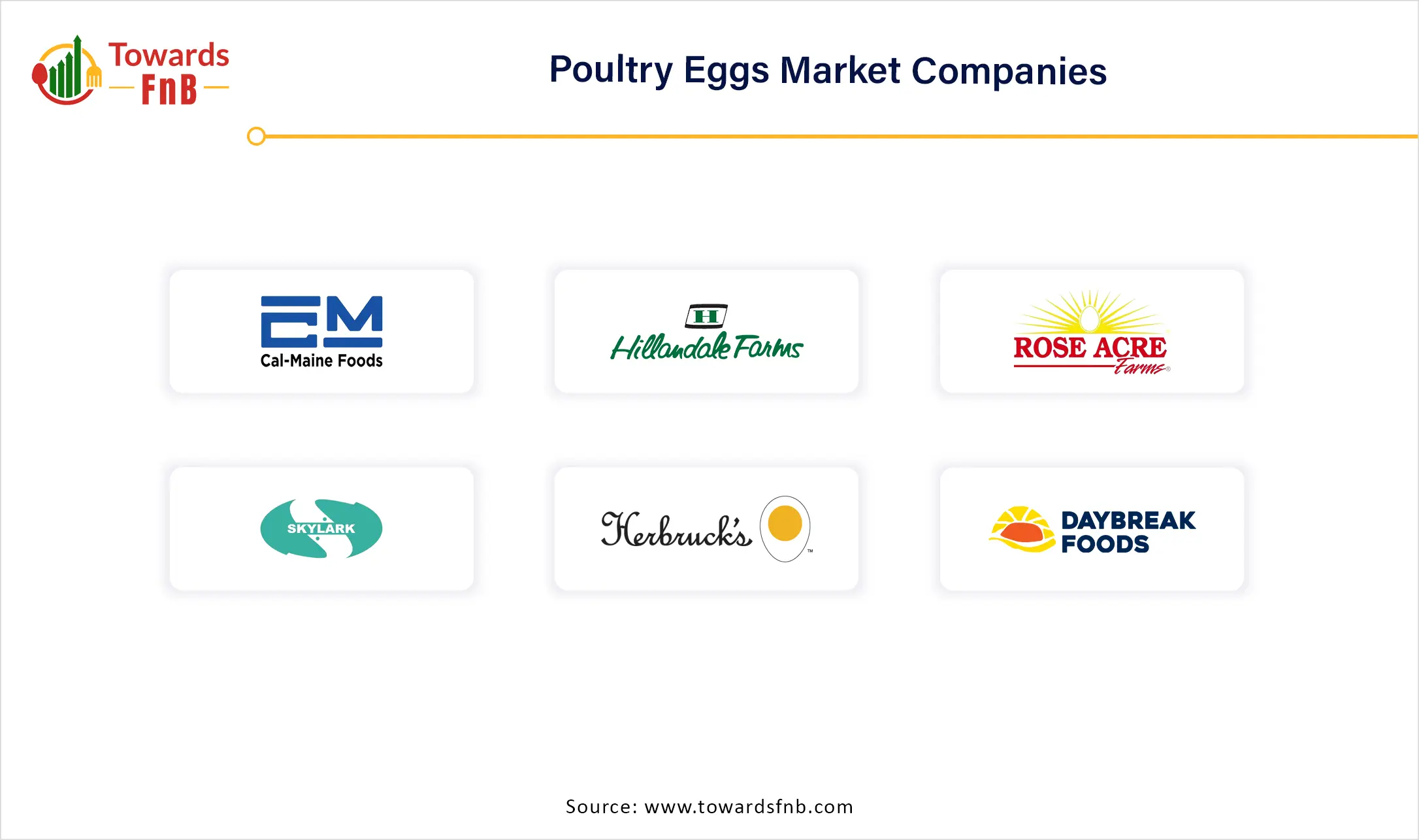December 2025
The global poultry eggs market size was valued at USD 94.54 billion in 2024 and is expected to grow steadily from USD 100.26 billion in 2025 to reach nearly USD 169.63 billion by 2034, with a CAGR of 6.04% during the forecast period from 2025 to 2034. The market is driven by different factors like growing population, shifting dietary preferences, and developments in poultry farming technology.

| Study Coverage | Details |
| Growth Rate from 2025 to 2034 | CAGR of 6.04% |
| Market Size in 2025 | USD 100.26 Billion |
| Market Size in 2026 | USD 106.32 Billion |
| Market Size by 2034 | USD 169.63 Billion |
| Largest Market | Asia pacific |
| Base Year | 2024 |
| Forecast Period | 2025 to 2034 |
| Regions Covered | North America, Europe, Asia-Pacific, Latin America, and Middle East & Africa |
Increasing awareness of health is driving the demand for poultry eggs, appreciated for their high protein levels and vital nutrients. Acknowledged as an essential part of the diet, eggs are valued for their contribution to general health. This trend indicates a move towards healthier dietary choices, leading to a rise in egg consumption as a nutritious and adaptable food choice which is expanding the market. Growing consumer awareness about healthier eating and a general rise in health consciousness have greatly impacted the market demand for eggs. Lately, poultry eggs market has experienced significant expansion fueled by heightened consumer interest in protein-rich diets, convenient food options, and the growing appeal of organic and free-range eggs. US table egg production reached 665.1 million dozen in January, a 2.6% increase compared to January 2023, as stated in the latest USDA Livestock, Dairy and Poultry Outlook report. The overall projection for table eggs in 2024 is 7,990 million dozen, reflecting a 1.6% increase compared to the previous year.
The poultry eggs market showcases numerous exciting opportunities, particularly as consumer preferences shift toward health-focused and eco-friendly food choices. An opportunity exists in the rising need for organic and free-range eggs. Furthermore, a growing market exists for functional and fortified eggs, such as omega-3 enhanced eggs and eggs with extra vitamins. With consumers looking for food items that provide added health advantages, these specialized eggs are emerging as an important segment in the industry. The ability to take advantage of these specialized categories presents a major chance for producers to broaden their range and enter the premium market.
Diseases, particularly avian influenza, present a major threat to the egg industry. The year 2024 has been recognized as one of the toughest for the worldwide poultry eggs market in recent times. The outbreak of highly pathogenic avian influenza affected major production areas such as the US, Europe, and Asia resulting in a significant decrease in supply and unprecedented price hikes. Plant-based alternatives and lab-cultured proteins are becoming popular as sustainable and ethical substitutes for conventional animal agriculture. This trend may lower the need for poultry eggs. Price fluctuations caused by variable feed expenses disrupt the egg market, resulting in uncertain prices for both producers and consumers.
Asia Pacific Dominated the Poultry Eggs Market in 2024.
One of the significant drivers is the spurring demand for high-protein and nutrient-rich foods, giving rise to boosted consumption of eggs. In addition, the growing urban population and the rising trend of health consciousness have attributed to the enhanced demand for eggs across the Asia Pacific. Nations like China and India, which have large populations, continue to drive the expansion of the market due to their strong demand for eggs as a staple in their daily diets. Furthermore, the growing exposure to worldwide cuisines, shifting consumer food habits, and increasing adoption of an eggetarian diet fostering the market.
The poultry sector in India has seen significant growth over the years, becoming one of the fastest-expanding segments of the agriculture industry. Due to a swiftly expanding population, rising protein intake, and evolving eating habits, poultry items have become a fundamental part of Indian homes. The sector plays a vital role in the economy, offering jobs to millions and being essential for nutritional security. Intelligent poultry farms featuring climate regulation systems, automated feeding mechanisms, and disease identification technologies are increasingly common in India.
The Indian government has been aiding the poultry industry with numerous programs and financial aids. As part of the National Livestock Mission, the central government offers a 50% subsidy up to Rs 25.00 Lakh for setting up Parent Farms, Rural Hatcheries, and brooder cum mother units to produce hatching eggs with at least 1000 parent layers and chicks, and for raising these chicks in the mother unit for up to four weeks. India presently exports around 200 million eggs each month to various countries in the Middle East, such as the UAE, Qatar, Oman, and Bahrain, as well as several African nations.
North America Expects the Significant Growth in the Market During the Forecast Period.
In recent times, the poultry industry in North America has experienced notable expansion and advancements in technology, production, consumption, and supply chains. The increasing intake of protein-rich foods in these areas is linked to the evolving purchasing behavior of consumers. Additionally, due to the swift rise in urbanization, the working demographic and more hectic lifestyles have influenced table egg consumption in the marketplace. In North America market is significantly shaped by consumer preferences for organic and free-range eggs, resulting in a rise in demand for locally-sourced and sustainable products.
Factors driving the poultry eggs market of Canada involve increasing protein intake, driven by fitness trends and an elder demographic desiring nutrient-rich foods, as processed eggs provide convenience while maintaining nutritional value. Urban growth increases the need for ready-to-eat and pre-cooked egg items, as environmentally aware shoppers advocate for cage-free and free-run egg sourcing, which corresponds with Canada's ethical farming image. The Canadian egg processing industry is undergoing significant change, driven by shifting consumer tastes, technological progress, and strong trade policies. A significant trend is the rising demand for clean-label and organic egg products, as health-minded Canadians emphasize transparency and sustainability.
How Shell Eggs Segment Dominated the Poultry Eggs Market in 2024?
Shell eggs segment dominated the market with the largest share in 2024. They can be boiled, poached, fried, scrambled, and added to numerous recipes, making them a highly versatile ingredient. From quiches and omelettes to custards and cakes, eggs are a crucial ingredient in a range of culinary dishes. In addition to their adaptability, eggs are highly nutritious. They serve as a great source of high-quality protein, supplying all the necessary amino acids that the human body needs. With changing consumer preferences towards healthier choices, there is an increasing demand in the shell eggs market for organic and free-range varieties.
Specialty Eggs Segment is Observed to Grow at the Fastest Rate During the Forecast Period.
Retailer commitments to cage-free and organic sourcing, certification, and legislative changes are all major factors driving the transition from conventional to specialty eggs. For ethical and health reasons, consumers want eggs that are organic, free-range, cage-free, omega-3, and pasture-raised. In order to meet customer demand and the clean-label trend, foodservice providers and bread manufacturers are also adding specialty eggs to their menus. This will help the specialty eggs segment grow over the projection period.
Which Application Segment Dominated the Poultry Eggs Market in 2024?
Household segment held the largest share of the market in 2024. In the Household application, eggs are commonly utilized for everyday cooking, baking, and nutrition because of their flexibility and protein value. Their benefits for eye health and performance, support in weight management, and enhancement of healthy skin have boosted household consumption of these eggs. Consumers are increasingly choosing specialty eggs for home cooking because of heightened awareness of health concerns, dietary limitations, and the rising popularity of organic and clean-label items.
Commercial Segment is Seen to Grow at a Notable Rate During the Predicted Timeframe.
The commercial application includes food service like restaurants, cafés, food production like ready-to-eat meals, baking, and additional sectors like pharmaceuticals. This sector has experienced swift expansion driven by the growth of the restaurant industry, the demand for convenience foods, and advancements in food processing. The restaurant industry is notably influential, as its expansion is directly linked to changes in consumer spending and lifestyles. The Commercial sector typically leads the market because of greater consumption by companies, enhanced by trends like rising dining-out habits and the expansion of convenience-oriented food items.
Which Distribution Channel Segment Held the largest Share of the Poultry Eggs Market in 2024?
Offline segment led the poultry eggs market in 2024. Physical stores, including convenience shops, specialty retailers, and extensive supermarkets and hypermarkets, provide hands-on experiences and instant satisfaction from purchases. Supermarkets and hypermarkets are the leading channel because of their wide range of products and comprehensive shopping experience, enabling customers to easily buy poultry eggs along with other groceries. Specialty shops emphasize unique, artisanal, or premium poultry eggs selections, appealing to a niche audience of customers looking for high-quality or distinctive poultry eggs offerings.
Online Segment is Expected to Grow at the Fastest CAGR in the Poultry Eggs Market During the Forecast Period.
Providing convenience via home delivery, a wide selection, and competitive pricing that attracts tech-savvy shoppers and individuals who favor the simplicity of online purchasing. The growing availability and accessibility of internet connections, along with the expanding coverage of mobile networks, are expected to boost the utilization of online shopping platforms. The GSMA states that the global mobile internet connection is steadily rising due to its affordability. Furthermore, the expansion of the online distribution channel is supported by the change in the consumer profile.
Tim Hortons
Happy Egg
Pete & Gerry’s Organics, LLC

By Product
By Application
By Distribution Channel
By Region
The global bromelain market size is projected to expand from USD 404.47 million in 2025 to USD 775.46 million by 2034, growing at a CAGR of 7.5% ...
December 2025
December 2025
December 2025
December 2025